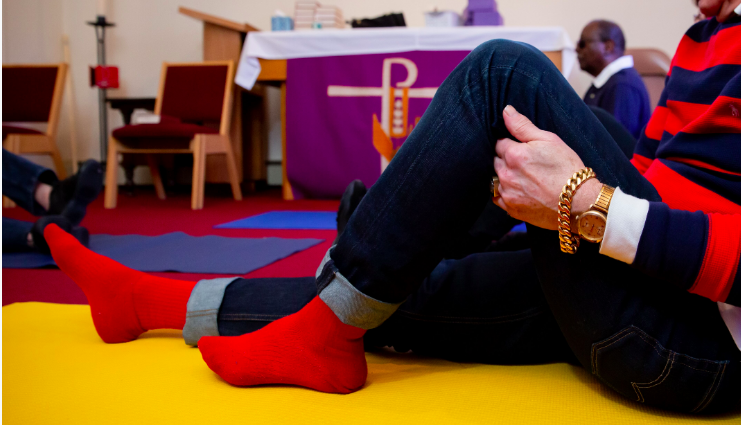
by admin | Apr 24, 2020 | Blog, News, Program
As part of our Beyond Sight series of programs we are offering Meditation and Mindfulness, an online class to help you cope with the stresses of everyday life. This class will be held at 1:30pm EST on Tuesdays through the week of June 8th, using the Zoom meeting platform.
There is no cost to participate, however registration is required and seating is limited. This program is open to all people with vision loss. Register in advance by clicking on the following link:
https://zoom.us/…/regist…/uJMpcumqpjMpKyFOZ0cDng4VVkxGz3M6NQ
After registering, you will receive a confirmation email containing information about joining the meeting. We look forward to having you in our classroom! For questions regarding Vision Loss Alliance of New Jersey and our programs please email us:
beyondsight@vlanj.org
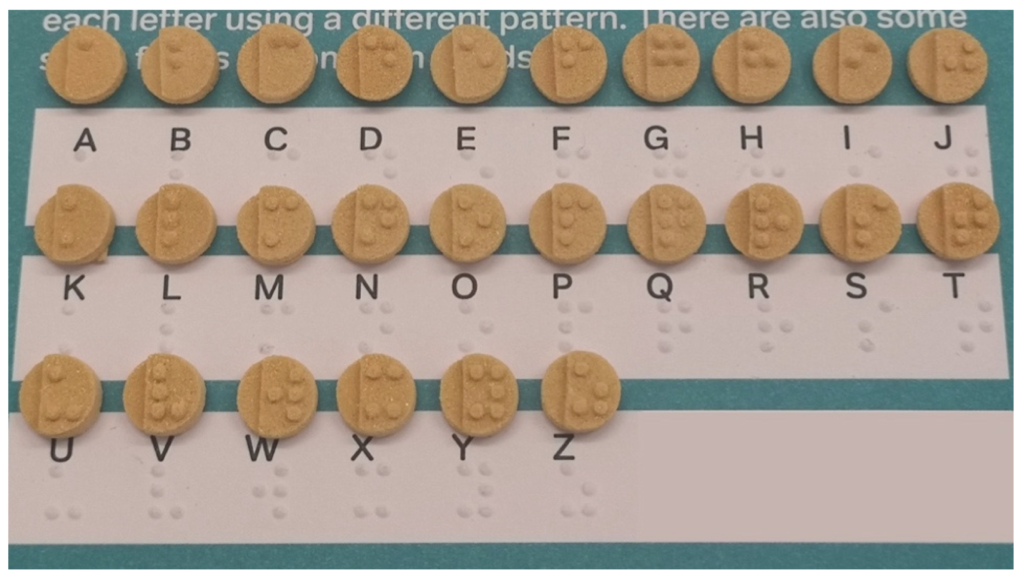
by admin | Apr 24, 2020 | Blog, News
Researchers from the UK and Spain continue to study the potential to use 3D printing to transform pharmaceuticals, outlining their studies in the recently published ‘3D Printed Tablets (Printlets) with Braille and Moon Patterns for Visually Impaired Patients.’
3D printed medication is an ongoing focus for scientists and manufacturers today, eager to put all the benefits of progressive technology to use. And while the use of Braille with printlets is a novel idea, it fits in perfectly with the idea of patient-specific treatment—meant to prevent dosage errors and encourage the visually impaired to keep up with their medication.
“Previous studies revealed that one of the leading causes of medication non-adherence was impaired vision, wherein approximately 97% of patients with visual impairment have difficulties reading medication labels, even in the presence of optical aids, and around 24% have difficulties in distinguishing medications,” stated the researchers. “Moreover, patients with visual impairment are twice more likely to need assistance with medicine management, wherein one-third of the patients will require continual support for medication administration.”
While Braille is ‘the universal tactile writing system,’ the Moon system stems from Latin Roman letters produced using raised shapes—much like the regular alphabet in structure. The researchers decided to print these writing systems directly onto the printlets.
SLS 3D printing was used to fabricate the orally disintegrating printlets (ODPs) with Braille and Moon patterns, allowing patients to have fast knowledge regarding medication. Paracetamol was used as the model drug.
“Moreover, as these printlets are designed to disintegrate rapidly in the mouth, they do not require the co-administration of water,” said the researchers. “As such, this encourages self-administration of medicines, improving patient compliance and treatment efficacy.”
In using an SLS 3D printer to etch the patterns into the printlets, the researchers noted that the exercise of doing so actually added weight to the printlets; in fact, just one Braille dot added a 3.8 percent increase in weight, while the Moon patterns added an increase of 4.9 percent. The patterns were, however, still visible as they allowed for tactile recognition.
As mechanical properties were evaluated, the researchers noted that in adding the patterns, the printlets were not affected.
Mechanical properties and disintegration times of the printlets with or without the addition of the Braille patterns.
Disintegration properties were not notably affected, and neither were release rates of drugs.
“Favorably, this technology offers the added benefit of using different shapes that could be inferred to a medication’s name, timing of intake (e.g., morning/evening), or its targeted indication (e.g., cardiovascular drugs),” concluded the researchers. “More importantly, as the pattern is directly printed on top of the tablet, the medication could be easily identified even when taken out of the packaging. This decreases the risk of medication errors and improves adherence to treatment. In addition, as these printlets disintegrate rapidly (e.g., within ~5 s), they avoid the need for water. This makes it easier for these patients to swallow the formulations, supporting self-administration and thus avoiding the need of a career.
“For the first time, this study demonstrates the use of 3D printing to fabricate personalized dosage forms targeted to blind or visually impaired individuals. The SLS 3D printing technique could be used to manufacture printlets with Braille or Moon patterns on their surface that could be read by blind individuals. It is likely that this innovative concept will provide a revolutionary approach for the treatment of visually impaired individuals, improving independence, medicine adherence and reducing medicine errors.”
Article via 3D Print. Full link: https://3dprint.com/264137/3d-printed-tablets-topped-with-braille-moon-patterns-help-visually-impaired-improve-in-taking-medication/
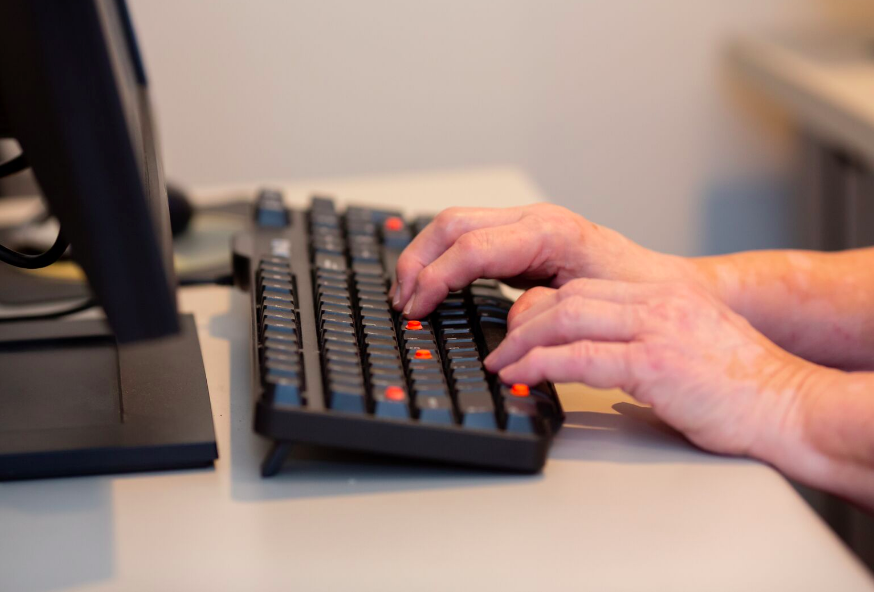
by admin | Apr 21, 2020 | Blog, News, Program
Vision Loss Alliance of New Jersey announces the addition of VLANJ Tech Talks to our virtual classroom. Led by VLANJ technology instructors Christina Brino and Susanne Sytsma, VLANJ Tech Talks is a monthly technology discussion forum which will kick-off with “Zooming” on Wednesday, April 29 from 7pm to 8pm. In this virtual session, we will lead you through a demonstration and discussion of the Zoom platform. Future topics include Navigating Facebook, What is Bard? Shop ’til you Drop, Amazon Basics, Getting started with Fusion, and more. The virtual program is open to all and there is no charge to participate. In order to register, please visit our Facebook page or email BeyondSight@vlanj.org. Membership includes monthly Tech Talks as well as inclusion in our member only VLANJ Tech Talks Facebook group.
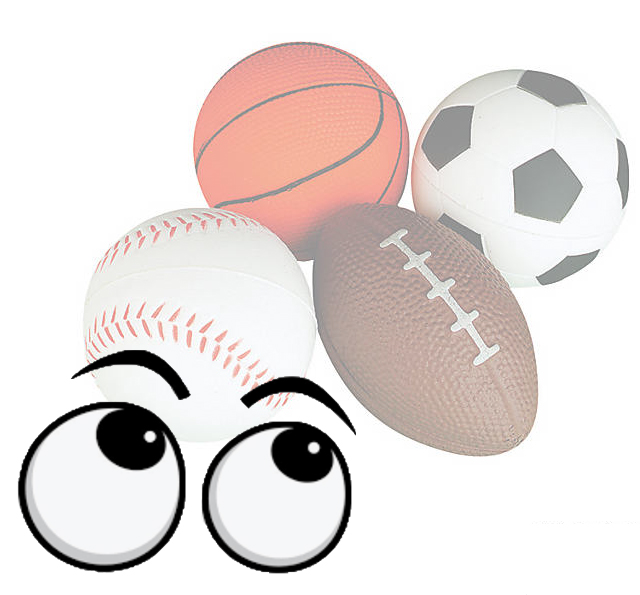
by admin | Apr 17, 2020 | Blog, News
Major sports league seasons have been canceled, contact sports have been shut down, but sports will continue to be a part of our daily lives, even while in quarantine. Whether you go fishing, golf in your back yard, shoot some hoops with your kids or play ping pong in your basement, each sport comes with a relative sense of risk for your eye safety.
Close to 30,000 sports-related injuries are treated in U.S. emergency rooms every year. Different activities come with different level of risk for eye injuries – sports with flying objects have a tendency to cause more damage. How can you protect your eyes? Wear appropriate protective eyewear! The American Academy of Ophthalmology reports that up to 90% of serious eye injuries could all be prevented by wearing eye protection.
You may ask yourself – what is proper eye protection then? Can’t I just wear my glasses? The truth is, contact lenses and glasses do not prevent eye injuries and you should avoid using regular eyeglasses as a preventative measure. Even more so, in some cases they can shatter and make injuries worse. There’s a handy list of different types of eye gear here, illustrating what you should wear for different sports.
So what should you do when you injure your eye? Go to the emergency room immediately, even if the injury appears minor. Some ophthalmologists are keeping their practices open for emergency care – if you’re not comfortable going to emergency care facilities at this time, keep handy the number of any local eye doctors that have emergency hours available. Delaying medical attention can result in permanent vision loss or blindness.
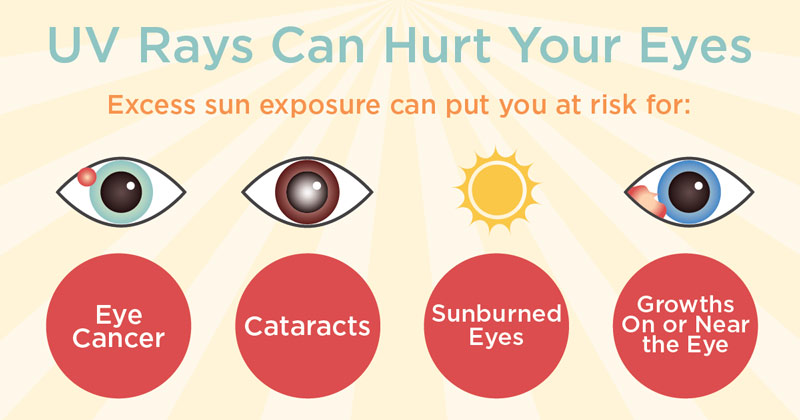
by admin | Apr 14, 2020 | Blog, News
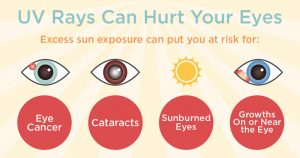
Summer and warmer weather are fast approaching. Most of us remember to wear sunscreen to protect our skin from sun damage, but it’s important to protect our eyes as well.
Excess sun exposure can put you at risk for eye cancer, sunburned eyes, cataracts, and growths on or near the eye. [Infographic above illustrates the same information].
How can you protect your eyes? Follow these guidelines:
Wear sunglasses labeled “100% UV protection”: Use only glasses that block both UV-A and UV-B rays and that are labeled either UV400 or 100% UV protection.
- Choose wraparound styles so that the sun’s rays can’t enter from the side.
- If you wear UV-blocking contact lenses, you’ll still need sunglasses.
Wear a hat along with your sunglasses; broad-brimmed hats are best.
Remember the kids: It’s best to keep children out of direct sunlight during the middle of the day. Make sure they wear sunglasses and hats whenever they are in the sun.
Know that clouds don’t block UV light: The sun’s rays can pass through haze and clouds. Sun damage to the eyes can occur any time of year, not just in summer.
Be extra careful in UV-intense conditions: Sunlight is strongest mid-day to early afternoon, at higher altitudes, and when reflected off of water, ice or snow.
By embracing these simple tips you and your family can enjoy being in the sun safely while protecting your vision.

by admin | Apr 6, 2020 | Blog, News, Program
Vision Loss Alliance of New Jersey is pleased to announce the opening of our new virtual classroom!
As part of our Beyond Sight series of programs we are offering Meditation and Mindfulness, an online class to help you cope with the stresses of everyday life. This class will be held at 1:30pm EST on Tuesdays from April 7, 2020 to April 28, 2020 using the Zoom meeting platform.
There is no cost to participate, however registration is required and seating is limited. Register in advance by clicking on the following link: Zoom Meeting.
After registering, you will receive a confirmation email containing information about joining the meeting. We look forward to having you in our classroom!
Would you like more information? Send us an email at beyondsight@vlanj.org.







